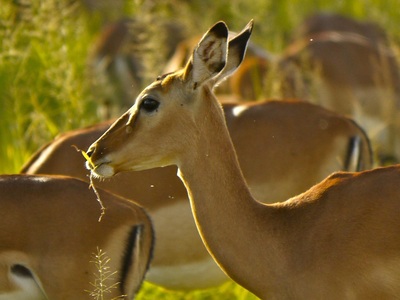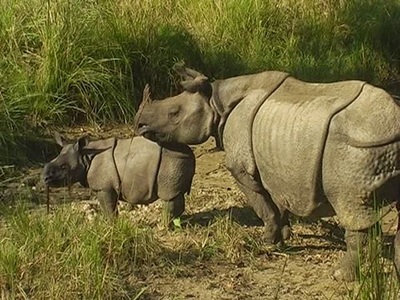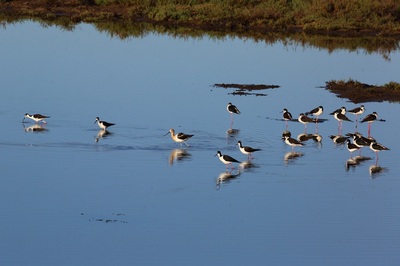TIGERS UP - Great 30% rise in the tiger population from 2011 to 2014It is right that we celebrate the good news, the great 30% rise in the tiger population from 2011 to 2014, on today's publication of the Government's Tiger census figures, and much of the credit must go to the sterling work of the protection staff,
who daily battle the forces of doom,
destruction, apathy and corruption.
Karnataka, with part of the great Western Ghats and its famous Bandipur and Nagarhole tiger reserves has
the highest number of tigers at 408 tigers followed by 340 in Uttarakhand, where Corbett Tiger reserve protects the great majority,
then 308 in Madhya Pradesh with its six tiger reserves including Bandhavgarh and Kanha, followed by 229 in Tamil Nadu,
190 in parks like Tadoba and Pench in Maharashtra,
167 in Kaziranga and Manas in Assam, 136 in the Kerala and
117 in Uttar Pradesh.
There is also a little loved and largely unrecognised industry that can take some justifiable pride in these figures too, (particularly as it was only two years ago it was being accused of killing tigers and being banned from parks!). Large population increases have been seen in parks with corresponding large visitor numbers. It's no coincidence.
Today, as these figures conclusively prove, nature tourism providing the invaluable economic imperative, the myriad of local jobs, and the millions of passionate advocates for the parks that still harbour the greatest densities of tigers in India.
There is a rapidly expanding market for nature travellers, each willing to pay to see their wild heritage, be it wild tigers, herds of elephant or unspoilt beaches where Olive Ridley turtles can nest. The market is growing at up to 25% per annum in parts of India, with over three millions people a year partaking. A TOFTigers' study in 2010 concluded that a single tiger in a well visited reserve is now worth an estimated US$750,000 per year in tourism revenues. When it only costs a few thousand dollars a year to preserve a tiger in the wild, this huge rate of return - the ROI in economist's jargon - is a figure no Government can ignore.
We know nature tourism can create the economic value that today's forests need to survive the politicians' red pen. Its revenues today supplement compensation for livestock killed, its mere presence ensures less poaching and wood extraction, and its jobs and opportunities give hope to some of India's most marginalised communities, for centuries buffeted by wildlife conflict, and new opportunity to benefit from its historic respect for forests and wildlife. The value of this industry also counters economic arguments to allow exploitative industries like forestry, agriculture or mining from gaining access to wild lands. You only have to look at the boon in tigers in Ranthambhore's southern sanctuary by shifting a few grazers from being livestock herders to becoming better paid guides to camera-toting visitors, to realise just how easily wild habitats can recover from over grazing and degradation.
Most worrying - as the global aim is to double the numbers of tigers in the wild by the next year of the Tiger in 2022 - is the rapid depletion of the many thousands of square kilometres of India's once vast yet unprotected forest tracts every year. There will simply be no livable space to meet this objective anymore, when all the best protected parks are full - as many are!
Wildlife tourism in India is by no stretch of the imagination perfect. Park Directors would rather close it down. Park visitors are treated like cattle. Nature education is often non-existent. Tourism development is unplanned and poorly executed. Yet in many well-known parks like Ranthambhore in Rajasthan, and Bandhavgarh and Kanha in Madhya Pradesh, visitors' park fees are already doubling or tripling the budgets that park managers have to protect their park and support their neighbouring communities. It's still far too few parks and it's still too unevenly spread - but it shows us the power of the future to transform tiger bearing landscapes - if only the authorities would provide a better roadmap to sustainability.
Nature tourism is, nevertheless, already providing the much needed bonding - the very glue - that makes long term forest conservation possible and economically viable, against a deafening crescendo of calls for nature's destruction, to be replaced by concrete development, fences, farms and dams. Global research today shows that over 75% of all visitors want more responsible holidays and 93% of nature travellers say travel companies should be committed to preserving natural heritage, so demand is not the issue - only supply!
Yes, tigers cannot survive without their protection staff, good management and large enough natural landscapes, but they will not thrive and expand without nature tourism's invaluable economics, its visitors' 'hearts on their sleeve' consciences, and communities willing to fight for living wildlife, because large carnivores are worth more to them alive than dead.
मै बहुत धैर्यवान हूँ, सच बोलना और सुनना पसंद है,
 दुधवा नेशनल पार्क के समीपवर्ती ग्राम भगवंतनगर एवं कोठिया के उच्च प्राथमिक विद्यालय में उतर प्रदेश सहभागी वन प्रबंध एवं निर्धनता उन्नमूलन कार्यक्रम जायका परियोजना वन विभाग के सीईपी कार्यक्रम के अर्न्तगत समाज कल्याण एवं विकास अध्ययन केन्द्र पीलीभीत द्वारा बाल पर्यावरण जागरूकता कार्यक्रम का आयोजन किया गया। जिसमें डब्ल्यूडब्लूएफ के सहायक परियोजना अधिकारी राधेश्याम भार्गव ने कहा कि हमारे चारों ओर भी जीवित घटक प्रकृति मौजूद है। जैसे पेड़- पौधे, कीट जीव- जन्तु हवा पानी सभी मिलकर पर्यावरण का निर्माण करते है। पर्यावरण के यह समस्त घटक एक दूसरे से प्रभावित होकर एक सन्तुलन में रहकर परिस्थिति तन्त्र को जन्म देते है। कोठिया जूनियर हाई स्कूल के अध्यापक संदीप अवस्थी ने बताया कि पृथ्वी पर प्रथम जीवन वनस्पति के रूप में आया, वनस्पतियों की असीमित वृद्वि के चलते अनेक जीव- जन्तु अस्तित्व में आए। इसी श्रंृखला में मानव का विकास हुआ मस्तिष्क की विशेषता के कारण कम शक्ति होने के बावजूद समय के साथ मानव ने अनेक जीव जन्तुओं को अपने जीवन में सहायक मानकर पालतू बनाया जो उनके साथ रहने लगे और आबादी से दूर वन व गैर आबाद क्षेत्र में रह गये। जिन्हे वन्यजीवों के रूप में जाने जाते है। वन्यजीयों के बीच बढ़ रहे संघर्ष को रोकने के लिए वन संरक्षण एवं सुरक्षा जरूरी हो गई है उन्होनें बच्चों से पेड़ लगाने की अपील की। इस दौरान संस्था के सह समन्वयक डीपी मिश्रा, अध्यापक शिवशंकर लाल त्रिवेदी, आर्दश अग्निहोत्री, विपिन कुमार, देवेन्द्र सिंह, प्रवीण तिवारी, जगमोहन, मुन्ना कादरी, आदि समेत तमाम अभिभावक मौजूद रहे।
दुधवा नेशनल पार्क के समीपवर्ती ग्राम भगवंतनगर एवं कोठिया के उच्च प्राथमिक विद्यालय में उतर प्रदेश सहभागी वन प्रबंध एवं निर्धनता उन्नमूलन कार्यक्रम जायका परियोजना वन विभाग के सीईपी कार्यक्रम के अर्न्तगत समाज कल्याण एवं विकास अध्ययन केन्द्र पीलीभीत द्वारा बाल पर्यावरण जागरूकता कार्यक्रम का आयोजन किया गया। जिसमें डब्ल्यूडब्लूएफ के सहायक परियोजना अधिकारी राधेश्याम भार्गव ने कहा कि हमारे चारों ओर भी जीवित घटक प्रकृति मौजूद है। जैसे पेड़- पौधे, कीट जीव- जन्तु हवा पानी सभी मिलकर पर्यावरण का निर्माण करते है। पर्यावरण के यह समस्त घटक एक दूसरे से प्रभावित होकर एक सन्तुलन में रहकर परिस्थिति तन्त्र को जन्म देते है। कोठिया जूनियर हाई स्कूल के अध्यापक संदीप अवस्थी ने बताया कि पृथ्वी पर प्रथम जीवन वनस्पति के रूप में आया, वनस्पतियों की असीमित वृद्वि के चलते अनेक जीव- जन्तु अस्तित्व में आए। इसी श्रंृखला में मानव का विकास हुआ मस्तिष्क की विशेषता के कारण कम शक्ति होने के बावजूद समय के साथ मानव ने अनेक जीव जन्तुओं को अपने जीवन में सहायक मानकर पालतू बनाया जो उनके साथ रहने लगे और आबादी से दूर वन व गैर आबाद क्षेत्र में रह गये। जिन्हे वन्यजीवों के रूप में जाने जाते है। वन्यजीयों के बीच बढ़ रहे संघर्ष को रोकने के लिए वन संरक्षण एवं सुरक्षा जरूरी हो गई है उन्होनें बच्चों से पेड़ लगाने की अपील की। इस दौरान संस्था के सह समन्वयक डीपी मिश्रा, अध्यापक शिवशंकर लाल त्रिवेदी, आर्दश अग्निहोत्री, विपिन कुमार, देवेन्द्र सिंह, प्रवीण तिवारी, जगमोहन, मुन्ना कादरी, आदि समेत तमाम अभिभावक मौजूद रहे।





